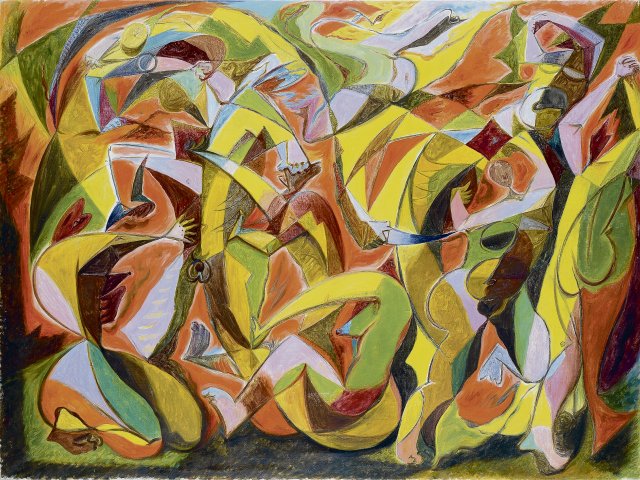André Masson (Balagny-sur-Thérain 1896–1987 Paris): Massacre, 1931, oil on canvas, New National Gallery © State Museums in Berlin, National Gallery, donation from the Ulla and Heiner Pietzsch Collection to the State of Berlin 2010
Photo: Jochen Littkemann © VG Bild Kunst, Bonn 2023
If you want to hear interesting conversations at the evening party, sit two completely different people next to each other, say: an undertaker and a lifeguard. Then the lifeguard might reveal that someone drowned in his house, and the undertaker might reveal that he can’t swim. This is roughly how one imagines the double exhibition of André Masson (1896–1987) and Ernst Wilhelm Nay (1902–1968) in the Scharf-Gerstenberg Collection in Berlin.
The two artists never met, did not notice each other, or at most only marginally noticed each other, and were as strangers to each other as only two people who happened to live at the same time can be strangers to each other. But precisely because he is now sitting next to a stranger, the Nay shows himself in a completely unfamiliar light. What we mostly know about him is what made him famous in the post-war period: “discs,” “rhythms,” “figurations,” non-binding abstractions that the progressive German citizen liked to hang in his office. The fact that the man also had a surrealist phase and took up mythological, sometimes painful themes is largely forgotten, but it has now come to light as he meets Masson, who was a well-known surrealist and often worked on mythological, painful, even tormenting themes.
But, between you and me, the museum is poor and couldn’t have afforded the late Nay anyway. However, the early one is in storage and was easy to combine with other artists. Since they didn’t want to call it “Accidental encounter of a Frenchman and a German on a dissecting table,” the curator Kyllikki Zacharias called it “Myth and Massacre.” “Myth” is clear, and “Massacre” is derived from the only prominent loan, the painting “Massacre” (1931) by Masson, which gave the curator the idea for the exhibition in the first place. Since she is very familiar with Nay, she was reminded of him by this picture. This too has something arbitrary about it.
“Massacre”, a highly stylized composition that puts together bright colors, especially from the yellow and orange spectrum, in flat compartments and lets them vibrate in semicircular curves, could have been based on Otto Freundlich just as well, if not much better. The colors have something orphic about them, and are also vaguely reminiscent of the Delaunay couple. The picture, on the other hand, is hardly reminiscent of a massacre, unless the massacre was staged by Ridley Scott, in whose “Napoleon” bloody bodies also whirl through the air. But are they even bloody here? Although bodies, including a female one, are clearly visible, they connect with each other more like dancing than tumbling, living rather than dying.
That’s strange. Masson was a vitalist; like Guillaume Apollinaire, the inventor of Orphism, he went happily into the First World War, but was seriously wounded. So if “Massacre” referred to the war, then Masson would have been, as Jean Paulhan put it, a “diligent soldier” who refused to be dissuaded by shrapnel. In our time, when artists have to undergo an embarrassing examination of conscience before every exhibition, this result was shocking, and the museum would have to be closed immediately for glorifying war.
But it could also be completely different and “massacre” could just be another word for “carom.” Then the attitude to life of many contemporaries would have been affected, who, like the Futurists, the Expressionists or the Cubists, were under the impression of the big city, machines, physical discoveries, i.e. the explosive development of the productive forces.
Since there isn’t much to the “massacre,” what about the “myth”? Doesn’t the myth classically contradict the impression of accelerated and catastrophic modernity? On the one hand, yes. On the other hand, the myth records a collective experience that, the more it is shattered by the atomization of capitalist society, celebrates happy origins in art, especially in the very latest art. It is then a thoroughly modern myth.
Nay, who always seems a bit sedate next to Masson, painted the well-known scene of Daphne’s pursuit by Apollo in 1946 as in tradition – Daphne already turns into a tree to save herself – but he breaks down the movement in a cubist way Apollo merges into the background. Yes, it seems that not only Daphne, Apollo was also transformed.
Nay’s “Daughter of Hecate” (1945) – meaning the “Younger Hecate”, i.e. Iphigenia – has abstracted the original figure of a woman with raised hands (Iphigenia at her sacrifice) in such a way that only fragments, body fragments, especially eyes, mainly in triangular shapes. This means that the myth here is no longer a story, but rather the dissolution of all stories; it does not offer characters, but rather the dismemberment of the figure. The old, collective knowledge is still behind it, but it has already lost its power. The modern myth is the myth of absence.
How can we point to the future beyond these sometimes disturbing finds? The exhibition makes things all too easy here. Of course, one is always happy about an Asger Jorn, but adding other contemporaries like Georg Meistermann and Theodor Werner who produced something remotely similar seems discouraged. Are there no younger artists, if not in our own depot, then in that of the Nationalgalerie? Well, let’s face it, Schmalhans is head chef for now, and until we’ve seen everything that’s still in the Berlin magazines, maybe a sponsor will come along, since the state prefers to invest its money in weapons.
»Myth and massacre. E. W. Nay and André Masson”, until April 28, 2024, Scharf-Gerstenberg Collection, Berlin.
#ndstays – Get active and order a promotional package

Regardless of whether it is pubs, cafés, festivals or other meeting places – we want to become more visible and reach everyone who values independent journalism with an attitude. We have put together a campaign package with stickers, flyers, posters and buttons that you can use to get active and support your newspaper.
To the promotional package
sbobet demo slot sbobet link sbobet
